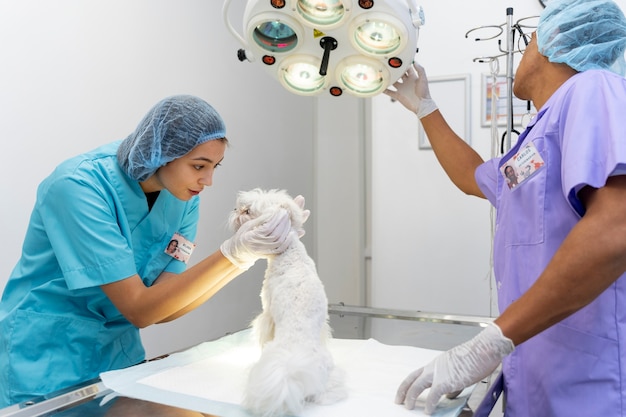How to Recognize Limping and Lameness in Pets


How to Recognize Limping and Lameness in Pets
If you notice your pet suddenly limping or showing signs of discomfort while moving, it’s natural to feel concerned. Limping in pets, whether in dogs, cats, or even small ruminants, can be alarming, especially when you aren’t sure what caused it or how serious it might be. At Hunterdon Hills Animal Hospital, located at 411 US Highway 22 East, Whitehouse Station, NJ 08889, our team of veterinarians understands how important it is for your companion to stay active and pain-free. This guide will help you recognize the signs of pet lameness, explore common pet lameness causes, and explain when to seek veterinary attention to ensure your pet’s swift recovery.
Throughout this blog, you’ll find practical advice on what to do if your pet starts limping, how to identify worrisome symptoms, and how local pet owners like you can find quality veterinary services near me for lameness and mobility issues. We’ll also highlight how our comprehensive orthopedic services in Whitehouse Station and surrounding communities can support your pet’s return to comfort and activity. If you’re ever unsure about your pet’s mobility, don’t hesitate to schedule an appointment with our caring veterinary professionals for an expert evaluation and personalized treatment plan.
Recognizing Limping and Lameness in Pets
What Does Limping Look Like in Pets?
Identifying limping in pets can sometimes be straightforward; other times, it may be subtle and easy to overlook. Limping refers to any irregularity in your pet’s gait or movement, whether it’s a sudden inability to put weight on one leg, a noticeable favoring of one side, or simply acting less playful and energetic during walks or playtime. In some cases, your pet may hesitate to jump onto furniture, climb stairs, or participate in activities they previously enjoyed.
For example, you might notice your dog pausing before going up steps, or your cat choosing to stay on the ground instead of leaping onto their favorite perch. Key symptoms include holding up a limb, shifting their weight away from a painful leg, or displaying an unusual hopping motion. Other signs are a reluctance to move, vocalizing during activity, or licking and chewing at a specific paw or leg. Occasionally, the signs can be as subtle as a change in posture or a decrease in activity, especially in cats who are known for masking discomfort.
When Is Limping an Emergency?
Some scenarios require immediate veterinary attention. If your pet’s limp is accompanied by swelling, severe pain when touched, bleeding, or the inability to rise or walk at all, these are signs of a more serious injury or condition that should not wait. Additionally, if your pet experiences sudden paralysis or dragging of a limb, or if you suspect a broken bone, it’s crucial to seek urgent veterinary care without delay.
If you are ever uncertain about whether your pet’s limp is urgent, our veterinary team at Hunterdon Hills Animal Hospital can help you determine the best course of action. We recommend reaching out for a professional evaluation if you notice any of these concerning symptoms, as prompt care can often prevent further complications and support a faster recovery.
Common Pet Lameness Causes: Why Is My Pet Limping?
Understanding the Underlying Reasons
Limping in pets can result from a wide range of issues, from minor sprains to more serious orthopedic or systemic problems. The most frequent pet lameness causes include soft tissue injuries such as sprains, strains, or bruises, as well as wounds or foreign objects lodged in the paw. More serious origins include ligament tears, such as anterior cruciate ligament (ACL) injuries, which are common in active dogs, or patellar luxation, where the kneecap slips out of place.
Other contributors are fractures and dislocations, which may be accompanied by visible deformities or swelling. In older pets, arthritis and degenerative joint disease often lead to chronic lameness, causing stiffness and intermittent limping that may worsen with exercise or changes in weather—something pet owners in Whitehouse Station and the surrounding areas may notice during cold or damp seasons.
Additionally, certain bone and joint infections, as well as growth plate injuries in puppies and kittens, can cause significant lameness. Less commonly, neurological conditions or tumors may also impact mobility. Each of these pet lameness causes requires a unique approach to diagnosis and care, highlighting the importance of seeking veterinary guidance to determine the underlying problem.
Professional Treatment Options for Limping in Pets
What to Expect During a Veterinary Visit
When you bring your pet to Hunterdon Hills Animal Hospital for limping in pets, our team of veterinarians will begin with a thorough physical examination and a detailed history of your pet’s symptoms. We may ask about when the limp started, any preceding injuries or activities, and how the symptoms have progressed. Diagnostic imaging such as digital radiology or veterinary ultrasounds may be recommended to identify fractures, joint issues, or soft tissue injuries. In some cases, advanced orthopedic evaluations or laboratory tests may be needed to rule out infections or systemic diseases.
Treatment options are tailored to your pet’s specific diagnosis. For mild sprains or strains, rest and anti-inflammatory medications may be sufficient. When more serious conditions are identified, such as ligament tears or fractures, surgical intervention may be necessary. Our hospital provides a full spectrum of orthopedic services, including orthopedic care for pets with musculoskeletal issues, ACL repair, and fractures and dislocations surgery, all performed by experienced veterinary professionals.
Post-surgical rehabilitation, pain management, and laser therapy are also available to support healing and comfort. Our veterinary team will explain the recommended treatment approach, answer your questions, and work with you to develop a plan that fits your pet’s needs and your family’s lifestyle.
How Long Will Recovery Take?
The recovery timeline for limping in pets depends on the underlying cause and the chosen treatment. Minor injuries may resolve within a few days to a week with rest and supportive care, while surgical recoveries can take several weeks to months. Throughout the healing process, we provide ongoing guidance for activity restrictions, pain management, and follow-up assessments to monitor your pet’s progress. Our goal is always to restore your pet’s mobility and quality of life while minimizing discomfort and risk of recurrence.
Preventing Limping and Supporting Your Pet at Home
Steps to Reduce the Risk of Lameness
While not all instances of limping in pets can be prevented, there are practical ways to reduce the risk of injury and support your companion’s joint health. Regular exercise tailored to your pet’s age, breed, and activity level helps maintain muscle strength and joint flexibility. Avoiding sudden jumps or rough play, especially in young puppies or breeds prone to joint issues, can lower the risk of sprains and ligament injuries.
Providing a well-balanced diet with appropriate nutrients, including joint-supportive supplements when recommended by your veterinarian, contributes to long-term musculoskeletal health. Maintaining a healthy weight is essential, as extra pounds put unnecessary strain on joints and can exacerbate arthritis or lameness. Safe home environments, such as non-slip flooring and accessible resting places, further protect your pet from accidental slips or falls.
Routine veterinary wellness care is vital for early detection and management of orthopedic conditions. Annual or semi-annual exams allow our veterinary team to monitor your pet’s gait, joint health, and overall mobility, catching subtle changes before they become significant problems. If you are interested in a thorough assessment of your pet’s musculoskeletal system, consider scheduling a wellness care visit to discuss preventive strategies and early intervention.
Home Care for Mild Limping
If your pet develops a mild limp but is still using the limb, resting them from strenuous activity and monitoring closely for changes is a good first step. Applying a cold compress to the affected area may help reduce inflammation, but this should be done with caution and only if your pet tolerates it well. Never give human medications to your pet, as some can be toxic or interfere with veterinary treatments. If the limp does not improve within 24 to 48 hours, or if your pet’s discomfort worsens, it is important to seek veterinary attention promptly.
When to Seek Veterinary Services for Limping in Whitehouse Station
Knowing When to Call the Vet
As a general rule, any sudden or severe limping, especially if your pet cannot bear weight on the limb, should be evaluated by a veterinarian as soon as possible. Additional warning signs that warrant immediate attention include visible swelling, significant pain, bleeding, open wounds, or a limb that appears at an abnormal angle. Chronic or intermittent lameness, even if mild, should also be discussed with your veterinarian to rule out underlying joint disease or other medical conditions.
If you are searching for a vet near me who can diagnose and treat limping in pets, look for a clinic with comprehensive orthopedic and diagnostic capabilities. At Hunterdon Hills Animal Hospital, our team of veterinarians is equipped to provide a full range of veterinary services in Whitehouse Station and surrounding communities, from routine wellness exams to advanced surgical care for fractures, ligament injuries, and more.
Compassionate Support and Expert Care for Your Pet’s Mobility
Limping in pets can be distressing for both you and your companion, but with timely intervention and expert care, most pets can make a full recovery and return to their favorite activities. If you notice signs of lameness or mobility issues, don’t wait for symptoms to worsen. Schedule an appointment with our compassionate veterinary team at Hunterdon Hills Animal Hospital for a comprehensive evaluation and personalized treatment plan. We are committed to providing quality veterinary services near me, ensuring pets in Whitehouse Station and the surrounding areas receive the care they need to stay healthy and active.
Whether your pet needs a comprehensive orthopedic assessment, help with an acute injury, or ongoing management for chronic joint conditions, we are here to help. Contact us today at (908) 923-7728 or visit our Whitehouse Station location to schedule your pet’s appointment. Your pet’s mobility matters, and we are honored to be your trusted choice for veterinary services in Whitehouse Station.
This article is intended for educational purposes only and should not be used as a substitute for professional veterinary advice. If your pet is limping or you have concerns about their health, please consult our veterinary team for an individualized assessment.


















